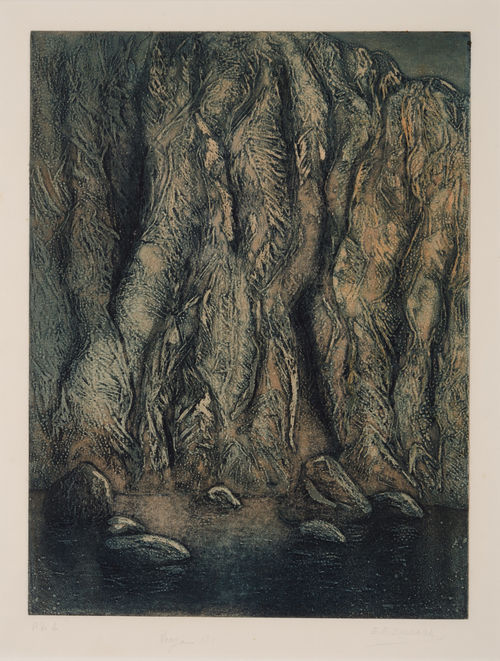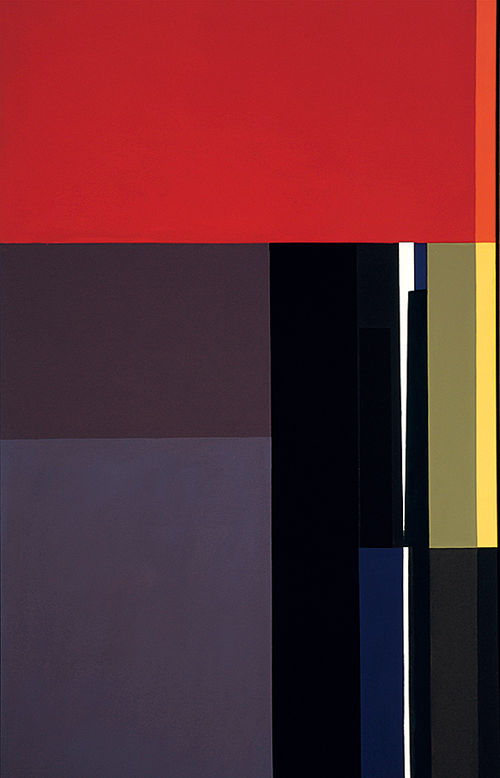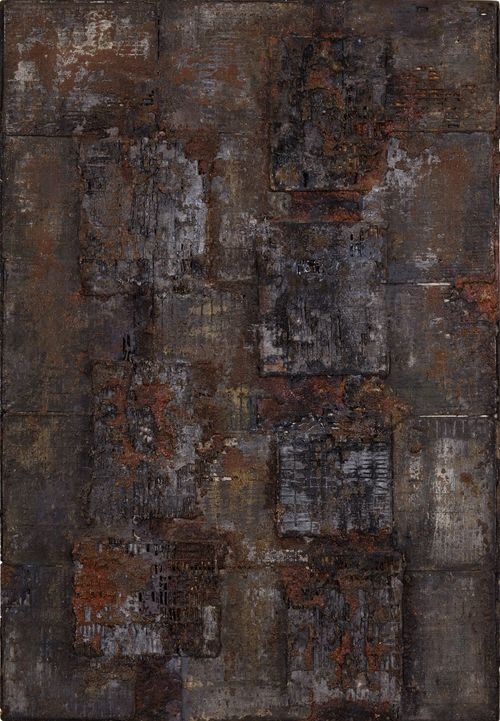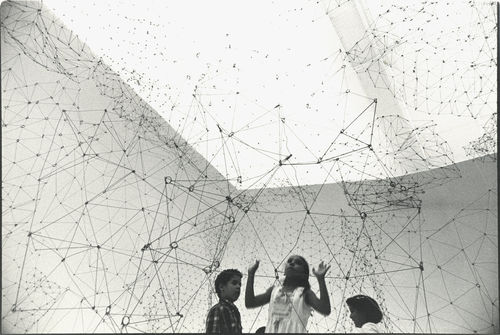Singular Women
Venezuela is a country of many great women artists. Particularly in the 1960s, women participated extensively in the art scene across many art disciplines, such as ceramics, painting, printmaking, and sculpture.# Throughout the 1960s and 1970s in Latin America, coinciding with political, social, and economic turmoil on the continent, artists developed different forms of conceptual and experimental art, and Venezuela was no exception. Nevertheless, given the strong drive for modernization in the 1950s during the dictatorship of Marcos Pérez Jiménez, geometric abstraction and modernist architecture became dominant and enduring styles,# making it difficult for the new experimental art forms that emerged in the 1960s and 1970s, such as performance and conceptual art, to gain a foothold.
Given the prevalence of abstraction in Venezuela between the 1950s and 1980s, we find many extraordinary women artists who worked in abstract idioms and, compared to other Latin American countries, fewer who created conceptual and politically engaged work. It follows that the Venezuelan artists whose work is featured in Radical Women represent only a small part of the larger art scene of the period. Nevertheless, these artists addressed in complex and powerful ways the dominant models of art. The discussion that follows provides a general overview of the women artists of the period with a focus on those represented in the exhibition.
Elisa Elvira Zuloaga (1900–1980) was the quintessential modern woman artist in Venezuela, one who was representative of a particular moment and participated in the trends of the time but whose work is never classifiable as strictly academic or abstract.# She developed a distinctive form of metaphysical landscape that went against the grain of the academic Arcadian landscape tradition associated with the Círculo de Bellas Artes. Later in her life she moved toward a type of nongeometric abstract printmaking (fig. 1). She was one of many modern women artists who, through dynamic and constant experimentation, contributed in unique ways to modern art. Their abstraction was never strictly definable as geometric or kinetic. For example, Mercedes Pardo's (1922–2005) chief investigation was color, freeing abstraction from formalism (fig. 2). Elsa Gramcko (1925–1994) moved from geometry into an organic abstraction to explore textures and matter, creating extraordinary oxidized surfaces with pigments into which she incorporated found objects (fig. 3). In the 1960s Gego (Gertrud Goldschmidt, Germany/Venezuela, 1912–1994) began producing modular organic abstractions that she called Reticuláreas (Reticule areas; fig. 4), which led to large-scale spatial explorations that moved away from established geometric abstraction.#
The year 1959 inaugurated the birth of democracy in Venezuela with the election of Rómulo Betancourt (1959–64).# Despite the agrarian reforms of 1960 and a new constitution in 1961, beginning in 1960 a radical left, influenced by the Cuban Revolution, took up an armed guerrilla struggle against the Venezuelan government.# In the context of this political turmoil, new art tendencies invested in political issues emerged while geometric abstraction continued to prosper. The most important ones were informalism,# which was seen as a counter to the neutrality of officially sanctioned geometric abstraction; a critical and politically charged new figuration; and the work of Techo de la Ballena (1961–68),# a radical multidisciplinary collective with a leftist political orientation, antiestablishment attitude, and Dada spirit, which was the precursor of conceptual art in Venezuela.
From the 1960s to the 1980s Venezuela, unlike other countries in Latin America, was not under a dictatorship, though the 1960s were years of political unrest.# It follows that conceptual art in Venezuela was not always politically activist. Antonieta Sosa (b. 1940), Yeni y Nan (active 1977–86), and Ani Villanueva (b. 1954) are the country's three key experimenters in the arena of performance art in this period.#
Excerpted from Radical Women: Latin American Art, 1960–1985. Copyright © 2017 by the Armand Hammer Museum of Art and Cultural Center, Inc. Published by DelMonico Books, an imprint of Prestel. The full essay can be found in the exhibition catalogue, available here.
Juan Carlos Palenzuela, Arte en Venezuela, 1959–1979: De El Techo de la Ballena a 11 Tipos (Caracas: CANTV, 2005).
A key example of modernism in Venezuela is the Ciudad Universitaria Universidad Central de Venezuela, built by Carlos Raúl Villanueva between 1944 and 1970, a project that integrated painting and sculpture with architecture. The Venezuelan artists Jesús Rafael Soto (1923–2005), Alejandro Otero (1921–1990), and Omar Carreño (1927–2013) were invited to produce large works alongside international artists such as Jean Arp, Alexander Calder, and Fernand Léger. Kinetic art was also hugely popular in the country, and Carlos Cruz-Diez was a key exponent.
Zuloaga's original style grew out of the conjunction of academic and modernist training. She studied at the Art Academy in Caracas and thereafter in Paris with André Lhote and in New York with Amédée Ozenfant.
Many more artists deserve mention here, including Mary Brandt (1917–1985), Marietta Berman (Czech Republic/Venezuela, 1917–1990), Dora Hersen (Puerto Rico/Venezuela, b. 1924), Luisa Richter (Germany/Venezuela, 1928–2015), and Maruja Rolando (1923–1970), who participated in Techo de la Ballena.
In 1947 President Rómulo Gallegos became Venezuela's first democratically elected leader. He was overthrown within eight months, however, in a military coup led by Marcos Pérez Jiménez, who remained in power until 1958.
The Movimiento de Izquierda Revolucionaria (MIR) was a left-wing Marxist party that became involved in guerrilla actions against the democratic government in the 1960s. During this time the MIR integrated with the Venezuelan Communist Party to form the so-called Armed Forces of National Liberation (FALN), which was actively involved in subversive actions during this period. Protest movements emerged from several sectors of Venezuelan society, particularly the universities, and were violently suppressed by the elected government.
Informalism is a type of abstraction devoid of rigorous structure and highlighting matter and texture. It is often gestural. Informalism was a prominent movement in Latin America between the 1950s and the 1970s.
The members of the group were Juan Calzadilla, Carlos Contramaestre, Daniel González, and Gabriel Morera, though other artists participated in the activities and exhibitions of Techo de la Ballena, such as Alberto Brandt and Maruja Rolando. Brandt, an underappreciated radical artist, had realized an experimental performance as early as 1958, expanding a gestural painting beyond the canvas and onto the wall before an audience.
As noted, Venezuela was under a dictatorship between 1948 and 1958. Brazil (1964–85), Argentina (1966–70, 1976–83), Uruguay (1973–85), Peru (1968–80), and Chile (1973–90) were under dictatorships at different times between the mid-1960s and 1990. In 1973, during Venezuela's oil boom, the oil and steel industries were nationalized. This inaugurated a period of bonanza, followed by excessive government spending and corruption. In 1983–84, with the drop in world oil prices, there were considerable cuts in government spending, generating civilian unrest. By 1989 the country had fallen into economic depression, leading to social and political turmoil, strikes, and riots. This is the backdrop for artists working between the 1970s and mid-1980s.
For a general account of performance in Venezuela, see Gabriela Rangel, "An Art of Nooks: Notes on Non-Objectual Experiences in Venezuela," in Arte ≠ Vida: Actions by Artists of the Americas 1960–2000, ed. Deborah Cullen (New York: El Museo del Barrio, 2008), 114–33.









